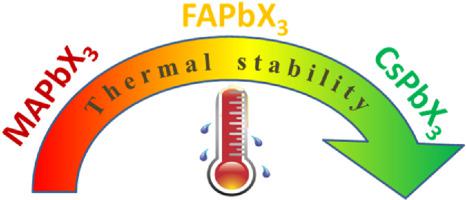当前位置:
X-MOL 学术
›
Sol. Energy Mater. Sol. Cells
›
论文详情
Our official English website, www.x-mol.net, welcomes your
feedback! (Note: you will need to create a separate account there.)
Intrinsic thermal decomposition pathways of lead halide perovskites APbX3
Solar Energy Materials and Solar Cells ( IF 6.3 ) Pub Date : 2020-08-01 , DOI: 10.1016/j.solmat.2020.110559 Azat F. Akbulatov , Vyacheslav M. Martynenko , Lyubov A. Frolova , Nadezhda N. Dremova , Ivan Zhidkov , Sergey A. Tsarev , Sergey Yu Luchkin , Ernst Z. Kurmaev , Sergey M. Aldoshin , Keith J. Stevenson , Pavel A. Troshin
Solar Energy Materials and Solar Cells ( IF 6.3 ) Pub Date : 2020-08-01 , DOI: 10.1016/j.solmat.2020.110559 Azat F. Akbulatov , Vyacheslav M. Martynenko , Lyubov A. Frolova , Nadezhda N. Dremova , Ivan Zhidkov , Sergey A. Tsarev , Sergey Yu Luchkin , Ernst Z. Kurmaev , Sergey M. Aldoshin , Keith J. Stevenson , Pavel A. Troshin

|
Abstract We present a systematic study on intrinsic thermal stability of a series of complex lead halides APbX3, used as absorber materials in perovskite solar cells. Mechanistically, the perovskites APbX3 were shown to decompose under thermal stress conditions initially to form PbX2 and AX salts. Thermolysis of the latter yields multiple volatile products, which were analyzed by mass spectrometry. We reconfirmed the CH3I + NH3 decomposition route for MAPbI3 and observed for the first time CH4, ethylene and HI (formed from CH3I). In case of FAPbI3, the formation of 2-aminomalononitrile (not 1,3,5-triazine as reported recently) was revealed along with NH4I and HCN. Importantly, the stability of the lead halide perovskites shows a good correlation with the volatility of univalent cation halides (or their decomposition products) incorporated in their structure. In particular, MAPbX3 have the lowest stability since they incorporate the most volatile (or easy to decompose) methylammonium halides MAX. On the contrary, all-inorganic CsPbX3 show remarkable compositional stability since CsBr and CsI are non-volatile under the solar cell operation conditions. The established relationship and material decomposition pathways provide important guidelines for rational design of novel absorber materials for perovskite solar cells with improved thermal stability suitable for terrestrial and space applications.
中文翻译:

卤化铅钙钛矿APbX3的固有热分解途径
摘要 我们系统地研究了一系列复杂的卤化铅 APbX3 的内在热稳定性,用作钙钛矿太阳能电池的吸收材料。从机制上讲,钙钛矿 APbX3 最初在热应力条件下分解,形成 PbX2 和 AX 盐。后者的热解产生多种挥发性产物,通过质谱法对其进行分析。我们再次确认了 MAPbI3 的 CH3I + NH3 分解路线,并首次观察到 CH4、乙烯和 HI(由 CH3I 形成)。在 FAPbI3 的情况下,与 NH4I 和 HCN 一起发现了 2-氨基丙二腈(不是最近报道的 1,3,5-三嗪)的形成。重要的,卤化铅钙钛矿的稳定性与结合在其结构中的单价阳离子卤化物(或其分解产物)的挥发性有良好的相关性。特别是,MAPbX3 的稳定性最低,因为它们包含了最易挥发(或易于分解)的甲基卤化铵 MAX。相反,全无机 CsPbX3 显示出显着的组成稳定性,因为 CsBr 和 CsI 在太阳能电池操作条件下是非挥发性的。已建立的关系和材料分解途径为钙钛矿太阳能电池的新型吸收材料的合理设计提供了重要指导,该材料具有适用于地面和空间应用的改进热稳定性。MAPbX3 具有最低的稳定性,因为它们包含最易挥发(或易于分解)的甲基卤化铵 MAX。相反,全无机 CsPbX3 显示出显着的组成稳定性,因为 CsBr 和 CsI 在太阳能电池操作条件下是非挥发性的。已建立的关系和材料分解途径为钙钛矿太阳能电池的新型吸收材料的合理设计提供了重要指导,该材料具有适用于地面和空间应用的改进热稳定性。MAPbX3 具有最低的稳定性,因为它们包含最易挥发(或易于分解)的甲基卤化铵 MAX。相反,全无机 CsPbX3 显示出显着的组成稳定性,因为 CsBr 和 CsI 在太阳能电池操作条件下是非挥发性的。已建立的关系和材料分解途径为钙钛矿太阳能电池的新型吸收材料的合理设计提供了重要指导,该材料具有适用于地面和空间应用的改进热稳定性。
更新日期:2020-08-01
中文翻译:

卤化铅钙钛矿APbX3的固有热分解途径
摘要 我们系统地研究了一系列复杂的卤化铅 APbX3 的内在热稳定性,用作钙钛矿太阳能电池的吸收材料。从机制上讲,钙钛矿 APbX3 最初在热应力条件下分解,形成 PbX2 和 AX 盐。后者的热解产生多种挥发性产物,通过质谱法对其进行分析。我们再次确认了 MAPbI3 的 CH3I + NH3 分解路线,并首次观察到 CH4、乙烯和 HI(由 CH3I 形成)。在 FAPbI3 的情况下,与 NH4I 和 HCN 一起发现了 2-氨基丙二腈(不是最近报道的 1,3,5-三嗪)的形成。重要的,卤化铅钙钛矿的稳定性与结合在其结构中的单价阳离子卤化物(或其分解产物)的挥发性有良好的相关性。特别是,MAPbX3 的稳定性最低,因为它们包含了最易挥发(或易于分解)的甲基卤化铵 MAX。相反,全无机 CsPbX3 显示出显着的组成稳定性,因为 CsBr 和 CsI 在太阳能电池操作条件下是非挥发性的。已建立的关系和材料分解途径为钙钛矿太阳能电池的新型吸收材料的合理设计提供了重要指导,该材料具有适用于地面和空间应用的改进热稳定性。MAPbX3 具有最低的稳定性,因为它们包含最易挥发(或易于分解)的甲基卤化铵 MAX。相反,全无机 CsPbX3 显示出显着的组成稳定性,因为 CsBr 和 CsI 在太阳能电池操作条件下是非挥发性的。已建立的关系和材料分解途径为钙钛矿太阳能电池的新型吸收材料的合理设计提供了重要指导,该材料具有适用于地面和空间应用的改进热稳定性。MAPbX3 具有最低的稳定性,因为它们包含最易挥发(或易于分解)的甲基卤化铵 MAX。相反,全无机 CsPbX3 显示出显着的组成稳定性,因为 CsBr 和 CsI 在太阳能电池操作条件下是非挥发性的。已建立的关系和材料分解途径为钙钛矿太阳能电池的新型吸收材料的合理设计提供了重要指导,该材料具有适用于地面和空间应用的改进热稳定性。











































 京公网安备 11010802027423号
京公网安备 11010802027423号